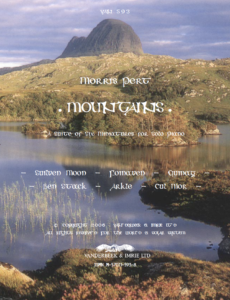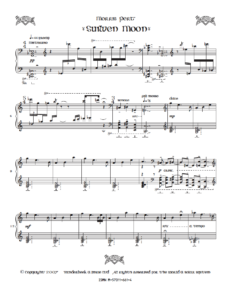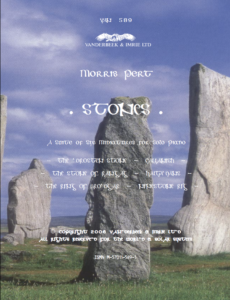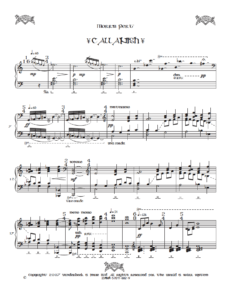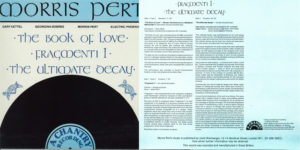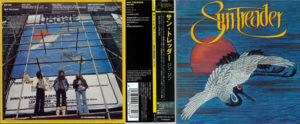Vanderbeek & Imrie Composers
Morris Pert

Morris Pert Facebook Group
MORRIS PERT was born in Arbroath, Scotland in 1947. He graduated B.Mus. from Edinburgh University in 1969, and on an Andrew Fraser scholarship, went on to study composition and percussion at the Royal Academy in London, where he was a pupil of Alan Bush. He was also an Associate of Trinity College London in Piano Teaching. While at the Academy he won several composition prizes including the 1970 Royal Philharmonic Award for his first orchestral work ‘Xumbu-Ata’.
Latterly Morris lived and worked in his own small studio in the far North-West of Scotland, concentrating on composition and electronic recording techniques, and working on his fourth symphony ‘De Situ Albanie’ and a work for Carnyx and tape.
Much of Mr. Pert’s music was inspired by the symbolism and the mystery surrounding the culture of the ancient inhabitants of Scotland known as the Picts and by his interest in the philosophical implications of the sciences of astronomy, cosmology and astrophysics.
His earlier music is published by Josef Weinberger, London. All his recent works are exclusively published by Vanderbeek & Imrie Ltd.
Morris died on 27th April 2010 and is sadly missed.
Selected works
- Missa Festiva for two-part choir (upper voices) and orchestra (or piano or organ)
- Mountains: A Suite of Six Miniatures for Solo Piano
- SUILVEN (2399′ – 731m) This mountain, like most of the others in this suite of characterisations, stands in isolation in north-west Sutherland. Its unique shape has led to a nick-name of “Sugar Loaf”. My first glimpse of Suilven was in midwinter about midnight, under a full moon. Magical!
- CUL MOR (2787′ – 849m) The most northerly peak in Wester Ross with twin summits capped with quartzite. It can look quite grim in dull and rainy weather, but is neverless magnificent.
- QUINAG (2653′ – 809m) Again a mountain of unique appearance, y-shaped in this case, in Sutherland. It is formed of ancient red Torridonian sandstone on a base of even more ancient Lewisian gneiss.
- BEN STACK (2364′ – 721m) Overlooking Loch Stack, this mountain, although not particularly high, has a beautiful conical shape, and its isolation emphasises its individuality.
- ARKLE (2580′ – 786m) An extraordinary, barren, and seemingly unattractive peak, which has suffered tremendous erosion over many thousands of years, resulting in great downfalls of scree near its base. To me, it’s a beautiful moonscape.
- FOINAVEN (2890′ – 908m) This enormous solitary ridge is composed of quartzite and consists of several peaks, the highest of which is “Ganu Mor”. It is always the first peak in the area to receive snow as winter approaches.
- Stones: A Suite of Six Miniatures for Solo Piano
- THE DROSTEN STONE This stone, now preserved in the St Vigeans Museum in Angus, is of the cross-slab type, i.e. a rectangular carved stone featuring a Celtic cross. Its main claim to fame is that it has, unusually, an inscription – Drosten ipe uoret ett forcus. Ett is the Latin “and”; ipe is in a completely unknown language (possibly Pictish); the other words are names. The stone may be a memorial to the personages mentioned. It dates from about 850AD.
- CALLANISH This awe-inspiring site of around 50 monoliths is situated on the Isle of Lewis in the Outer Hebrides. The site consists of circles and avenues of Lewisian gneiss stones, some 15 to 20 feet high and in fantastical shapes, and dates from Neolithic times (about 4,000 years ago). Many stones have clear alignments, with the sun, moon and certain stars; and in the centre is a chambered cairn, which may have been used as an altar. The whole location has an air of mystery and magic about it.
- THE STONE OF RANGAG Situated on the Hill of Rangag, just north of Latheron in Caithness, this is the most conspicuous and striking of several solitary standing stones in the area. It is a four-sided pillar, standing 9 feet high, and it probably dates from the Bronze Age. It has no markings but has certain astronomical and geographical alignments.
- HALTADANS High on a hill on the island of Fetlar in Shetland is a stone circle 37 feet in diameter. This ancient circle consists of stones of serpentine no higher than 2 feet. There are also 2 further similar stones in the centre of the circle. Folklore has it that the two central stones are a fiddler and his wife, while the outer circle represents fairy dancers who were turned to stone – petrified – because they were still dancing when the sun came up. Haltadans, a word from the ancient Norn language, means literally “halting dance”, for in Shetland folklore fairies limp when dancing.
- THE RING OF BRODGAR Overlooking the Loch of Stenness on Mainland Orkney, this magnificent ring of 27 monoliths, from 6 to 15 feet in height, dates from the third millenium B.C. The whole site is 370 feet in diameter and originally had about 60 stones. One stone has a Norse runic inscription thought to translate as Bjorn. As at Callanish, there are many astronomical alignments, particularly in relation to the solstices and equinoxes. This is a very beautiful and evocative site.
- NINESTONE RIG An oval of standing stones situated 10 miles south of Hawick in Roxburghshire, 23/21 feet in diameter. It dates from the early Bronze Age. There are 8 stones, the highest about 6 feet tall, all leaning inwards, and a ninth completely fallen inwards. The rig is located deep in (modern) coniferous forest.
Morris Pert LPs for sale
‘The Book of Love’, ‘Fragmenti I’ and ‘The Ultimate Decay’ – LP available for £10.00 plus P&P – only a few left!
‘Zin-Zin’ by Morris Pert/Suntreader: CD available from Disk Union (sales restricted to Japan); a few used LPs available from us for £10.00 plus P&P.
